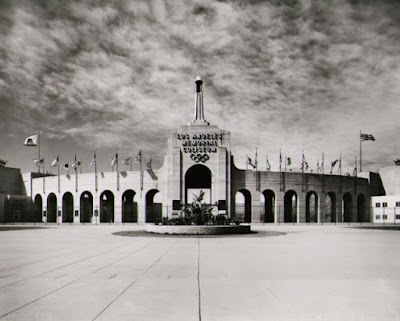 |
(Detail), Official Poster of the Xth Olympiad in Los Angeles, 1932
Courtesy Southern California Committee for the Olympic Games
|
On August 5, the 2016 Summer Olympics officially begins in Rio de Janeiro. Though Los Angeles lost the bid to host this year’s games, California’s City of Angels welcomed the world in the summers of 1932 (X Olympiad) and 1984 (XXIII Olympiad) and won the American candidate city for the 2024 Summer Olympics (XXXIII Olympiad).
As we anticipate the start of “Rio 2016” (XXXI Olympiad), we look back to the 1932 Summer Olympics in Los Angeles. The times were financially difficult—the world was in the midst of the Great Depression—and Southern California was considered geographically isolated, driving up travel costs. Nevertheless, from July 30 to August 14, the number of tickets sold to visitors eager to watch 1,332 athletes from 37 countries compete in the games totaled about 1.2 million—approximately the same number as the city’s 1930 census. Thousands of children attended the games, made possible by a low price of 50 cents for all events and half-price season tickets.
Though participation was the lowest since 1904, the 1932 games brought a number of innovations and distinctive features to Olympics history—including the introduction of the Olympic Village to the games (for male athletes), the first use of the 3-level victory podium to award medals, the largest crowd (about 100,000) to attend the Opening Ceremony, and the largest stadium (Los Angeles Memorial Coliseum, renamed Olympic Stadium).
 |
Olympic Village, Baldwin Hills, 1932
Courtesy of Los Angeles Public Library
|
Olympic Fencing Champions on Victory Podium, 1932
Courtesy of usfencingresults.org
(Left to right) Heather Guinness (Great Britain, silver), Ellen Preis (Austria, gold), and Erna Bogen (Hungary, bronze); (left to right) Joseph Levis (USA, silver), Gustavo Marzi (Italy, gold), and Giulio Gaudini (Italy, bronze) |
 |
Opening Day at Olympic Stadium (Los Angeles Memorial Coliseum), July 30, 1932
Games of the Xth Olympiad, Los Angeles 1932, Official Report, 1933
|
The City of Los Angeles rose to the occasion, enlarging the Los Angeles Memorial Coliseum and establishing a complete transportation system for the athletes and Olympics officials, a traffic control program every day of the events, and a public relations campaign boasting the city’s many attributes. A major thoroughfare in Los Angeles—Tenth Street—was renamed Olympic Boulevard in honor of the games.
It can be said that the 1932 Olympics helped shape Los Angeles’s metropolitan identity. As Mark Dyreson and Matthew Llewellyn have proposed, “Los Angeles used the 1932 games to put itself on the global map” and “provided the basic template for modern Olympic mega-productions.”
Shelly Kale
Publications and Strategic Projects Manager
Sources
“80 Years Ago This Week: Los Angeles Welcomes (and Transports) the World to the 1932 Summer Olympics,” July 24, 2012; Primary Resources, Metro Transportation Library and Archive, http://metroprimaryresources.info/80-years-ago-this-week-los-angeles-welcomes-and-transports-the-world-to-the-1932-summer-olympics/4156/
Mark Dyreson and Matthew Llewellyn, “Los Angeles Is the Olympic City: The 1932 and 1984 Olympic Games,” The International Journal of the History of Sport 25, no. 14 (2008): 1991–2018
The Games of the Xth Olympiad, Los Angeles 1932, Official Report (Xth Olympiade Committee of the Games of Los Angeles, U.S.A., 1932, Ltd., 1933)
“Los Angeles 1932: Highlights of the Game,” https://www.olympic.org/los-angeles-1932








No comments:
Post a Comment